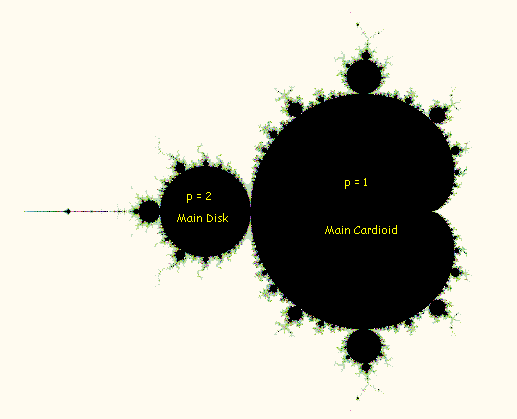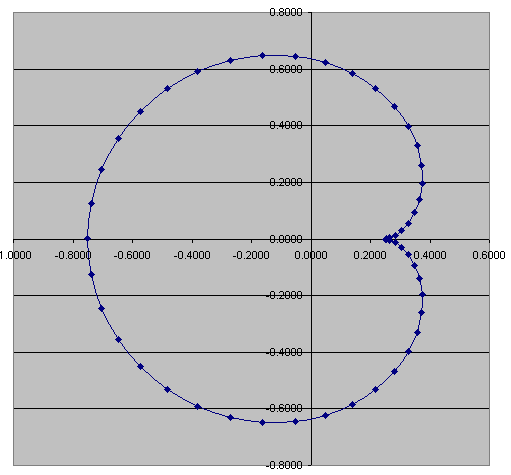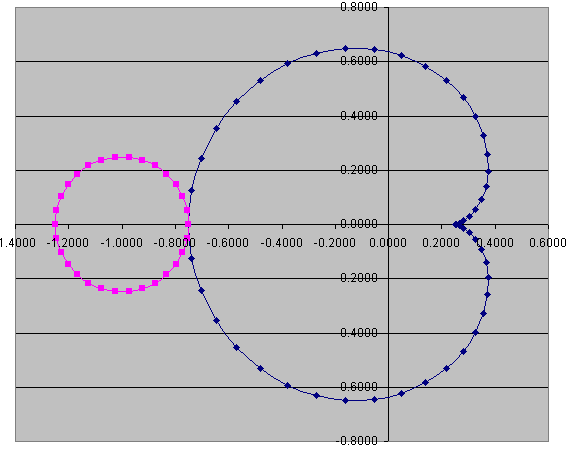
[back to Cosine Kitty's math page]
 |
| Figure 1: The Mandelbrot Set with p=1 and p=2 regions labeled |
We start with the value z = 0, then calculate subsequent z values by squaring z, adding c, and storing the result back as a new value of z.
To be more precise, we are forming an infinitely long list of distinct z-values. Let us refer to each value in the list using an integer subscript, like this: z[n], where n = 0, 1, 2, 3, .... We always start with
z[0] = 0
and we calculate each subsequent value using:z[n] = (z[n−1])2 + c
for n = 1, 2, 3, ...
In general, if we iterate the Mandelbrot formula z2 + c a positive integer p times, and we end up back where we started, we say that we have found a periodic orbit with the value p. In mathematical notation,
z[n + p] = z[n]
So, we can restate the description of the Main Cardioid as the set of all c such that Z has a periodic orbit of p = 1. We shall call such Z a fixed point. This leads to the equationZ2 + c = Z
Solving for c in terms of Z, we getc = Z − Z2
This tells us that for every point c that has orbital period p = 1, there must exist at least one Z such that Z − Z2 = c. This is nice to know, but it doesn't help us understand what the shape of all c with period 1 looks like.Now we ask, what happens if we feed a slightly different value through this function? Furthermore, what if we take the result and keep iterating it, by repeatedly feeding it back through the function? We don't expect the new sequence of z values to immediately repeat, but they might eventually settle down into a new fixed point. Or then again, they might not... we could end up diverging to infinity or settling into an orbital period other than 1.
In math notation, we are defining a new series of complex numbers w[n], where
w[0] = z + ε
w[n] = f(w[n−1]); n = 1, 2, 3, ...
According to the Banach Fixed Point Theorem, if |(∂/∂z) f(z)| < 1 and f(z) = z, then for sufficiently small nonzero values of ε, iterating w[n] as described above leads to convergence to a new fixed point w[∞] = W. We describe this value of z as an attractive point of the function f.
Alternatively, if the derivative of f at z has a magnitude greater than 1, the series w[n] will diverge away from z as n increases. This will happen no matter how close to zero ε gets, so long as ε ≠ 0. The series may zoom off to infinity, it may settle down into a periodic orbit away from z, or it could even be chaotic, jumping around in a seemingly random fashion, all depending on the particulars of the function f and the value z. Such values of z that push nearby values z+ε away are appropriately called repelling points.
The only possibility that remains is the marginally stable condition |(∂/∂z) f(z)| = 1. We refer to these values of z as indifferent points.
|(∂/∂z) (z2 + c)| = |2z| = 1
The set of complex numbers whose maginutide is 1 can be represented using Euler's Identity in terms of an angle θ as follows:
2z = eiθ = cos(θ) + i sin(θ)
z = eiθ / 2
c = z − z2
c = eiθ/2 − (eiθ/2)2
c = eiθ/2 − e2iθ/4
 |
| Figure 2: Main Cardioid plotted using c = eiθ/2 − e2iθ/4. |
u = c − ¼
u = ½ eiθ − ¼(1 + e2iθ)
u = ½ eiθ − ¼(e−iθ + eiθ) eiθ
u = ½ eiθ − ¼(2 cos(θ)) eiθ
u = eiθ (1 − cos(&theta)) / 2
A = ∫2π0 |u|2 / 2 dθ
A = ∫2π0 (1 − 2cos(θ) + cos2(θ)) / 8 dθ
A = ∫2π0 (1 − 2cos(θ) + ½(1 + cos(2θ))) / 8 dθ
A = ∫2π0 (2 − 4cos(θ) + (1 + cos(2θ))) / 16 dθ
A = ∫2π0 (3 − 4cos(θ) + cos(2θ)) / 16 dθ
A = 3π/8 = 1.178097245096...
z2 + c ≠ z
or
c ≠ z − z2
Okay, now back to where we left off. Given
f(z) = z2 + c
we are trying to solve for
f(f(z)) = z
(z2 + c)2 + c = z
c2 + (1 + 2z2)c + (z4 − z) = 0
Using the quadratic formula, we can find two solutions for c in terms of z:
c = ½ (−(1+2z2) ±
√((1+2z2)2 − 4(z4 − z)))
c = ½ (−(1+2z2) ±
(2z + 1))
| Solution #1 | Solution #2 |
| c = z − z2 | c = −z2 − z − 1 |
Now we can define a new function F(z) = f(f(z)). Notice that a binary oscillation point of f is the same as a fixed point of F, so the same analytical approach we used on the Main Cardioid will work if applied to F. We use the indifference constraint as before:
(∂/∂z) F(z) = eiθ
(∂/∂z) ((z2 + c)2 + c) = eiθ
4z(z2 + c) = eiθ
4z(z2 + (−z2 − z − 1)) = eiθ
4z(−z − 1) = eiθ
4z(z + 1) = −eiθ
z2 + z = −eiθ / 4
−c = z2 + z + 1
z2 + z = −c − 1
−c − 1 = −eiθ / 4
And solving for c, we get the solution for the boundary of the binary oscillation region of the Mandelbrot Set:c = ¼ eiθ − 1
This formula describes a perfect circle, centered at −1 with a radius of ¼. The Main Disk thus has an area of π/16 = 0.196349540849.... It is interesting to note that the Main Disk's area is exactly 1/6 the area of the Main Cardioid. Adding the two regions together yields an area of 7π/16 = 1.3744467859455..., which is about 91% of the total area of the Mandelbrot Set. See also [Areas of Mandelbrot fractals].Using Microsoft Excel again, I plotted this formula and superimposed its graph on the cardioid graph to obtain:
 |
| Figure 3: Main Cardioid and Main Disk plotted together. |
Compare this with Figure 1, and you see that the derivation produces a matching image with the brute force approach used to calculate the whole Mandelbrot fractal. It is remarkable that a set defined in terms of infinite iterations can have significant portions explained using exact analytic techniques.
 |
| Figure 4: The Mandelbrot Set with p=3 regions labeled |
The problem is daunting. First, we start with the triply iterated Mandelbrot function set equal to z:
z = f(f(f(z))) = ((z2 + c)2 + c)2 + c
Expanding the binomials, we get:z = (c + c2 + 2c3 + c4) + (4c2 + 4c3)z2 + (2c + 6c2)z4 + (4c)z6 + z8
Then, we subtract z from both sides of the equation, and rearrange as a polynomial in c:0 = (−z + z8) + (1 + 2z4 + 4z6)c + (1 + 4z2 + 6z4)c2 + (2 + 4z2)c3 + c4
As happened in the p=2 case, the Main Cardioid is lurking here as a redundant solution. We use polynomial division by (−z + z2) + c to obtain:0 = (1 + z + z2 + z3 + z4 + z5 + z6) + (1 + 2z + 3z2 + 2z3 + 3z4)c + (2 + z + 3z2)c2 + c3
This equation can be solved for c in terms of z, but doing so will require using the Cubic Formula, which is hard enough if the coefficients are numbers, let alone polynomial expressions! Once that is solved, we go back to the boundary constraint:
(∂/∂z) f(f(f(z))) =
(8c2 + 8c3)z
+ (8c + 24c2)z3
+ (24c)z5
+ 8z7
= eiθ
(c2 + c3)z
+ (c + 3c2)z3
+ (3c)z5
+ z7
= eiθ / 8
That's as far as I've gotten so far. I do intend to tackle this problem, but I thought I would go ahead and publish my partially finished work in the mean time. [Stay tuned!]